1997 SSANGYONG KORANDO engine
[x] Cancel search: enginePage 1506 of 2053
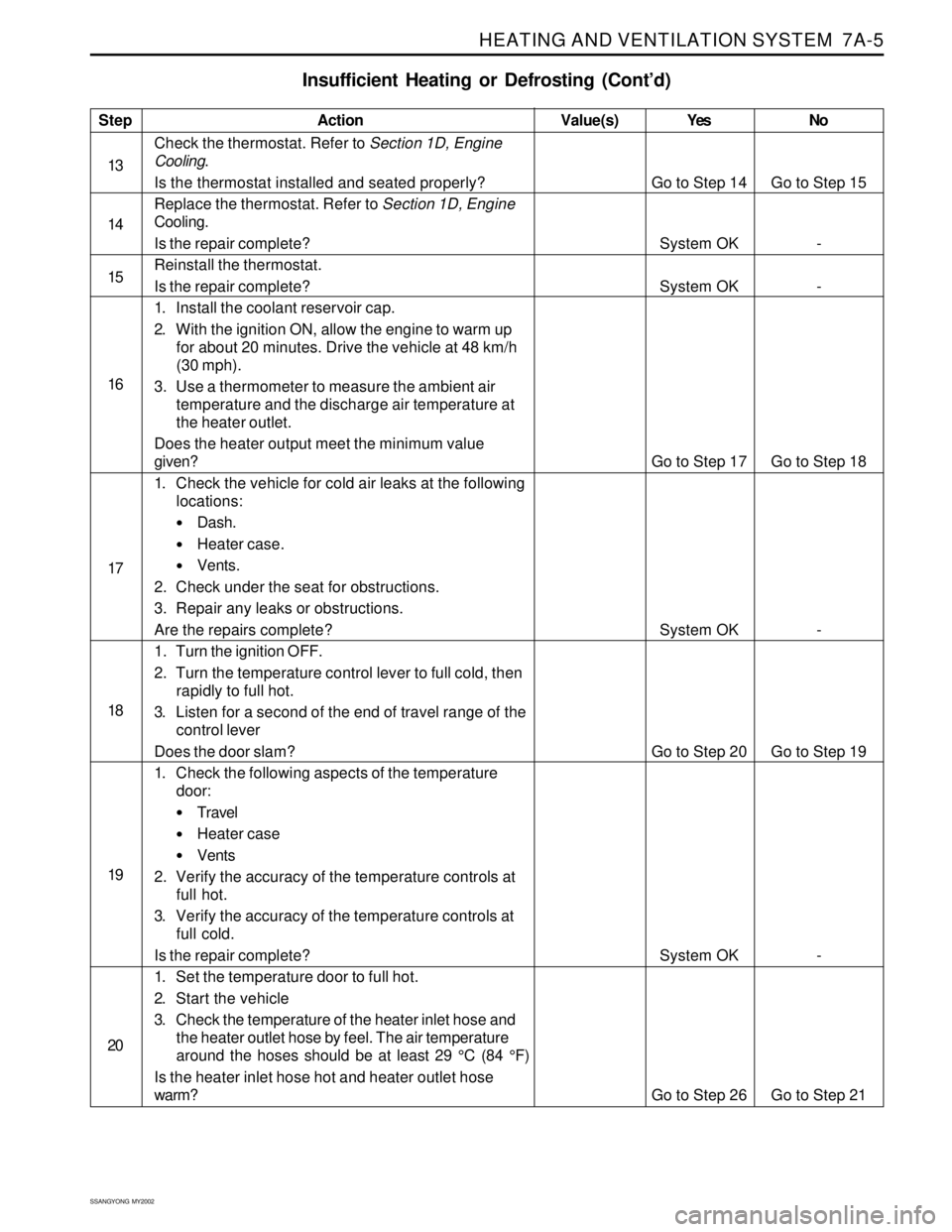
HEATING AND VENTILATION SYSTEM 7A-5
SSANGYONG MY2002
Insufficient Heating or Defrosting (Cont’d)
Step
13
14
15
16
17
18
19
20Action
Check the thermostat. Refer to Section 1D, Engine
Cooling.
Is the thermostat installed and seated properly?
Replace the thermostat. Refer to Section 1D, Engine
Cooling.
Is the repair complete?
Reinstall the thermostat.
Is the repair complete?
1. Install the coolant reservoir cap.
2. With the ignition ON, allow the engine to warm up
for about 20 minutes. Drive the vehicle at 48 km/h
(30 mph).
3. Use a thermometer to measure the ambient air
temperature and the discharge air temperature at
the heater outlet.
Does the heater output meet the minimum value
given?
1. Check the vehicle for cold air leaks at the following
locations:
Dash.
Heater case.
Vents.
2. Check under the seat for obstructions.
3. Repair any leaks or obstructions.
Are the repairs complete?
1. Turn the ignition OFF.
2. Turn the temperature control lever to full cold, then
rapidly to full hot.
3. Listen for a second of the end of travel range of the
control lever
Does the door slam?
1. Check the following aspects of the temperature
door:
Travel
Heater case
Vents
2. Verify the accuracy of the temperature controls at
full hot.
3. Verify the accuracy of the temperature controls at
full cold.
Is the repair complete?
1. Set the temperature door to full hot.
2. Start the vehicle
3. Check the temperature of the heater inlet hose and
the heater outlet hose by feel. The air temperature
around the hoses should be at least 29 °C (84 °F)
Is the heater inlet hose hot and heater outlet hose
warm?Yes
Go to Step 14
System OK
System OK
Go to Step 17
System OK
Go to Step 20
System OK
Go to Step 26No
Go to Step 15
-
-
Go to Step 18
-
Go to Step 19
-
Go to Step 21 Value(s)
Page 1507 of 2053
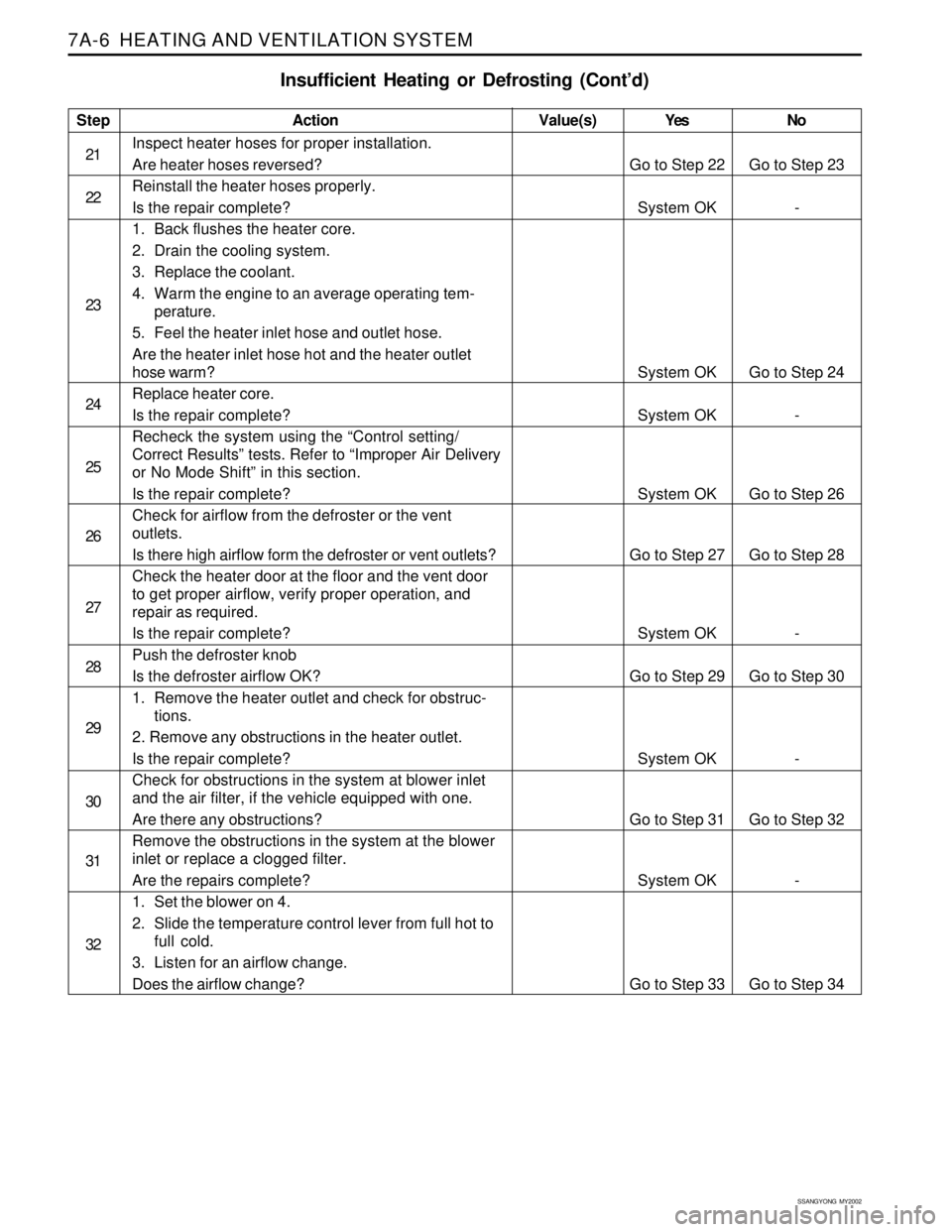
SSANGYONG MY2002
7A-6 HEATING AND VENTILATION SYSTEM
Insufficient Heating or Defrosting (Cont’d)
Step
21
22
23
24
25
26
27
28
29
30
31
32Action
Inspect heater hoses for proper installation.
Are heater hoses reversed?
Reinstall the heater hoses properly.
Is the repair complete?
1. Back flushes the heater core.
2. Drain the cooling system.
3. Replace the coolant.
4. Warm the engine to an average operating tem-
perature.
5. Feel the heater inlet hose and outlet hose.
Are the heater inlet hose hot and the heater outlet
hose warm?
Replace heater core.
Is the repair complete?
Recheck the system using the “Control setting/
Correct Results” tests. Refer to “Improper Air Delivery
or No Mode Shift” in this section.
Is the repair complete?
Check for airflow from the defroster or the vent
outlets.
Is there high airflow form the defroster or vent outlets?
Check the heater door at the floor and the vent door
to get proper airflow, verify proper operation, and
repair as required.
Is the repair complete?
Push the defroster knob
Is the defroster airflow OK?
1. Remove the heater outlet and check for obstruc-
tions.
2. Remove any obstructions in the heater outlet.
Is the repair complete?
Check for obstructions in the system at blower inlet
and the air filter, if the vehicle equipped with one.
Are there any obstructions?
Remove the obstructions in the system at the blower
inlet or replace a clogged filter.
Are the repairs complete?
1. Set the blower on 4.
2. Slide the temperature control lever from full hot to
full cold.
3. Listen for an airflow change.
Does the airflow change?Yes
Go to Step 22
System OK
System OK
System OK
System OK
Go to Step 27
System OK
Go to Step 29
System OK
Go to Step 31
System OK
Go to Step 33No
Go to Step 23
-
Go to Step 24
-
Go to Step 26
Go to Step 28
-
Go to Step 30
-
Go to Step 32
-
Go to Step 34 Value(s)
Page 1509 of 2053
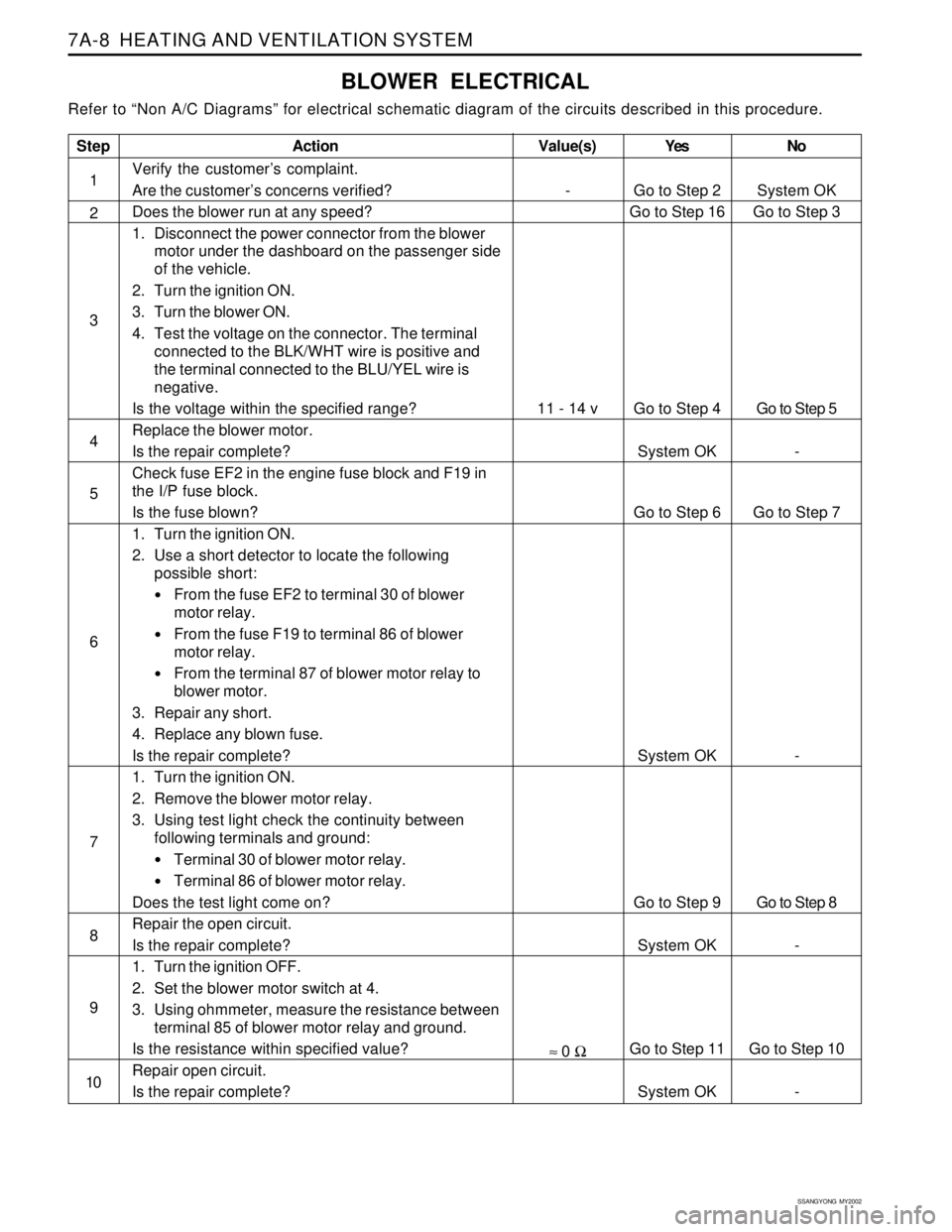
SSANGYONG MY2002
7A-8 HEATING AND VENTILATION SYSTEM
BLOWER ELECTRICAL
Refer to “Non A/C Diagrams” for electrical schematic diagram of the circuits described in this procedure.
Step
1
2
3
4
5
6
7
8
9
10
Action
Verify the customer’s complaint.
Are the customer’s concerns verified?
Does the blower run at any speed?
1. Disconnect the power connector from the blower
motor under the dashboard on the passenger side
of the vehicle.
2. Turn the ignition ON.
3. Turn the blower ON.
4. Test the voltage on the connector. The terminal
connected to the BLK/WHT wire is positive and
the terminal connected to the BLU/YEL wire is
negative.
Is the voltage within the specified range?
Replace the blower motor.
Is the repair complete?
Check fuse EF2 in the engine fuse block and F19 in
the I/P fuse block.
Is the fuse blown?
1. Turn the ignition ON.
2. Use a short detector to locate the following
possible short:
From the fuse EF2 to terminal 30 of blower
motor relay.
From the fuse F19 to terminal 86 of blower
motor relay.
From the terminal 87 of blower motor relay to
blower motor.
3. Repair any short.
4. Replace any blown fuse.
Is the repair complete?
1. Turn the ignition ON.
2. Remove the blower motor relay.
3. Using test light check the continuity between
following terminals and ground:
Terminal 30 of blower motor relay.
Terminal 86 of blower motor relay.
Does the test light come on?
Repair the open circuit.
Is the repair complete?
1. Turn the ignition OFF.
2. Set the blower motor switch at 4.
3. Using ohmmeter, measure the resistance between
terminal 85 of blower motor relay and ground.
Is the resistance within specified value?
Repair open circuit.
Is the repair complete?Yes
Go to Step 2
Go to Step 16
Go to Step 4
System OK
Go to Step 6
System OK
Go to Step 9
System OK
Go to Step 11
System OKNo
System OK
Go to Step 3
Go to Step 5
-
Go to Step 7
-
Go to Step 8
-
Go to Step 10
-
Value(s)
-
11 - 14 v
≈ 0 Ω
Page 1515 of 2053
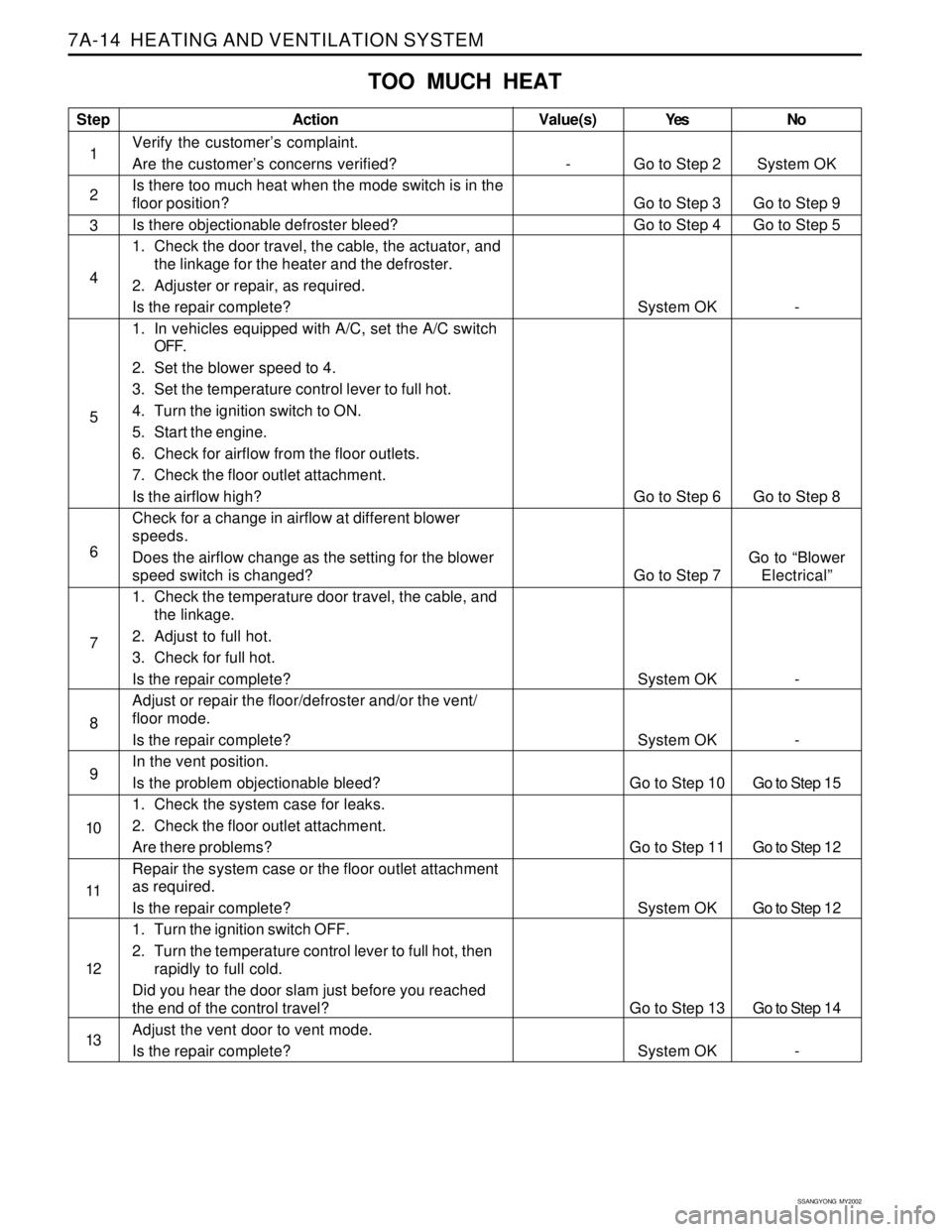
SSANGYONG MY2002
7A-14 HEATING AND VENTILATION SYSTEM
TOO MUCH HEAT
Step
1
2
3
4
5
6
7
8
9
10
11
12
13Action
Verify the customer’s complaint.
Are the customer’s concerns verified?
Is there too much heat when the mode switch is in the
floor position?
Is there objectionable defroster bleed?
1. Check the door travel, the cable, the actuator, and
the linkage for the heater and the defroster.
2. Adjuster or repair, as required.
Is the repair complete?
1. In vehicles equipped with A/C, set the A/C switch
OFF.
2. Set the blower speed to 4.
3. Set the temperature control lever to full hot.
4. Turn the ignition switch to ON.
5. Start the engine.
6. Check for airflow from the floor outlets.
7. Check the floor outlet attachment.
Is the airflow high?
Check for a change in airflow at different blower
speeds.
Does the airflow change as the setting for the blower
speed switch is changed?
1. Check the temperature door travel, the cable, and
the linkage.
2. Adjust to full hot.
3. Check for full hot.
Is the repair complete?
Adjust or repair the floor/defroster and/or the vent/
floor mode.
Is the repair complete?
In the vent position.
Is the problem objectionable bleed?
1. Check the system case for leaks.
2. Check the floor outlet attachment.
Are there problems?
Repair the system case or the floor outlet attachment
as required.
Is the repair complete?
1. Turn the ignition switch OFF.
2. Turn the temperature control lever to full hot, then
rapidly to full cold.
Did you hear the door slam just before you reached
the end of the control travel?
Adjust the vent door to vent mode.
Is the repair complete?Yes
Go to Step 2
Go to Step 3
Go to Step 4
System OK
Go to Step 6
Go to Step 7
System OK
System OK
Go to Step 10
Go to Step 11
System OK
Go to Step 13
System OKNo
System OK
Go to Step 9
Go to Step 5
-
Go to Step 8
Go to “Blower
Electrical”
-
-
Go to Step 15
Go to Step 12
Go to Step 12
Go to Step 14
-Value(s)
-
Page 1516 of 2053
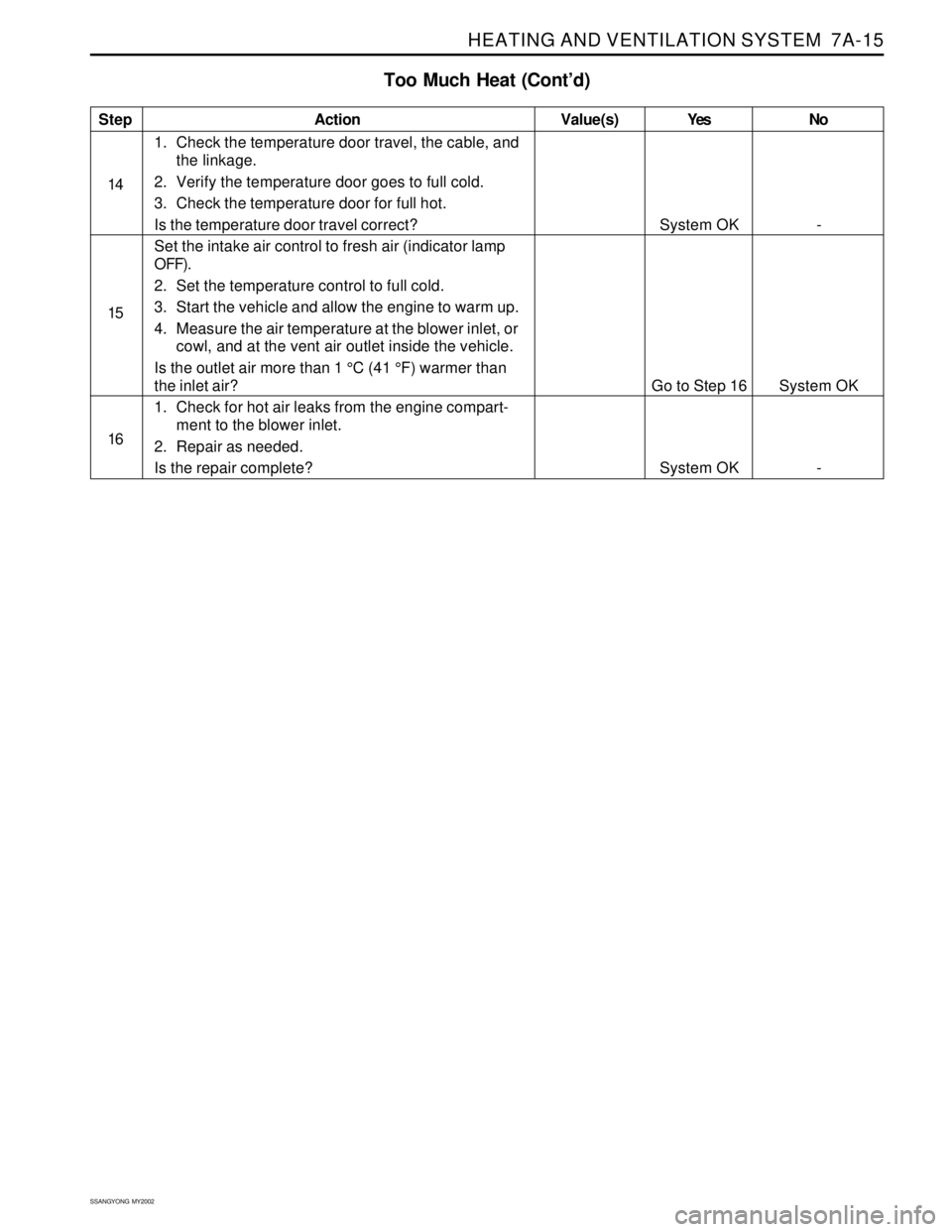
HEATING AND VENTILATION SYSTEM 7A-15
SSANGYONG MY2002
Too Much Heat (Cont’d)
Step
14
15
16Action
1. Check the temperature door travel, the cable, and
the linkage.
2. Verify the temperature door goes to full cold.
3. Check the temperature door for full hot.
Is the temperature door travel correct?
Set the intake air control to fresh air (indicator lamp
OFF).
2. Set the temperature control to full cold.
3. Start the vehicle and allow the engine to warm up.
4. Measure the air temperature at the blower inlet, or
cowl, and at the vent air outlet inside the vehicle.
Is the outlet air more than 1 °C (41 °F) warmer than
the inlet air?
1. Check for hot air leaks from the engine compart-
ment to the blower inlet.
2. Repair as needed.
Is the repair complete?Yes
System OK
Go to Step 16
System OKNo
-
System OK
-Value(s)
Page 1517 of 2053

SSANGYONG MY2002
7A-16 HEATING AND VENTILATION SYSTEM
BLOWER NOISE
Step
1
2
3
4
5
6
7
8
9
10
11
12
13
14Action
Verify the customer’s complaint.
Are the customer’s concerns verified?
1. Sit inside the vehicle.
2. Close the doors and windows.
3. Turn the ignition ON.
4. Start the engine.
5. Set the temperature to full cold.
6. Cycle through the blower speeds, the modes, and
the temperature settings in order to find the noise.
Is the blower noise constant at high blower speeds or
in other modes?
Check for vibrations from the blower motor and fan
assembly at each blower speed by feeling the blower
motor housing.
Did you find excessive vibration?
1. Remove the blower motor and fan assembly.
Refer to “Blower Motor” in this section.
2. Check for foreign materials at the opening of the
blower inlet.
Did you find any foreign materials at the blower inlet?
Remove all foreign materials.
Is the repair complete?
1. Examine the blower fan for wear spots, cracked
blades, a cracked hub, a loose fan retaining nuts,
or bad alignment.
2. Examine the blower case for sports.
Did you find any problem?
Repair as required.
Is the repair complete?
Replace the motor and fan assembly.
Is the repair complete?
If the noise is a click/tick or whine, replace the motor.
Is the repair complete?
Reinstall the original motor.
Is the problem still present?
1. Set the blower speed on 4.
2. Check full hot to full cold temperature positions in
the defroster, floor, and vent modes.
Is the noise present in the defrost mode only?
1. Check the ducts for obstructions for foreign
materials.
2. Remove any obstructions or foreign materials.
3. Check floor /defroster door seals.
4. Repair or replace as needed.
Is the repair complete?
Is the noise present in the floor mode only?
Is the noise present in the vent mode only?Yes
Go to Step 2
Go to Step 11
Go to Step 6
Go to Step 5
System OK
Go to Step 7
System OK
System OK
System OK
Go to Step 11
Go to Step 12
System OK
Go to Step 12
Go to Step 15No
System OK
Go to Step 3
Go to Step 4
Go to Step 6
Go to Step 6
Go to Step 9
Go to Step 8
Go to Step 9
Go to Step 10
System OK
Go to Step 14
-
Go to Step 14
Go to Step 16Value(s)
-
Page 1524 of 2053
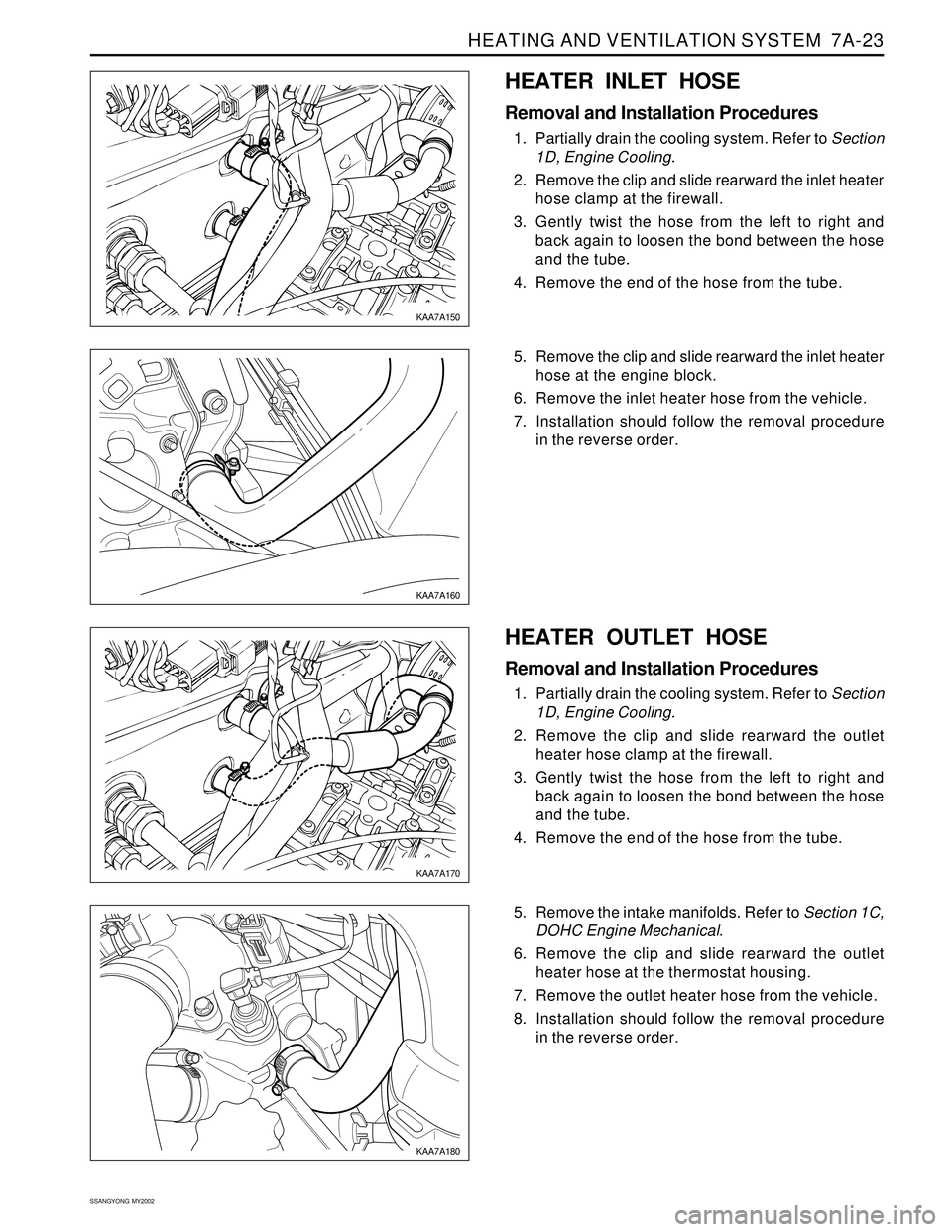
HEATING AND VENTILATION SYSTEM 7A-23
SSANGYONG MY2002
HEATER INLET HOSE
Removal and Installation Procedures
1. Partially drain the cooling system. Refer to Section
1D, Engine Cooling.
2. Remove the clip and slide rearward the inlet heater
hose clamp at the firewall.
3. Gently twist the hose from the left to right and
back again to loosen the bond between the hose
and the tube.
4. Remove the end of the hose from the tube.
KAA7A150
KAA7A160
KAA7A170
KAA7A180
5. Remove the clip and slide rearward the inlet heater
hose at the engine block.
6. Remove the inlet heater hose from the vehicle.
7. Installation should follow the removal procedure
in the reverse order.
HEATER OUTLET HOSE
Removal and Installation Procedures
1. Partially drain the cooling system. Refer to Section
1D, Engine Cooling.
2. Remove the clip and slide rearward the outlet
heater hose clamp at the firewall.
3. Gently twist the hose from the left to right and
back again to loosen the bond between the hose
and the tube.
4. Remove the end of the hose from the tube.
5. Remove the intake manifolds. Refer to Section 1C,
DOHC Engine Mechanical.
6. Remove the clip and slide rearward the outlet
heater hose at the thermostat housing.
7. Remove the outlet heater hose from the vehicle.
8. Installation should follow the removal procedure
in the reverse order.
Page 1530 of 2053
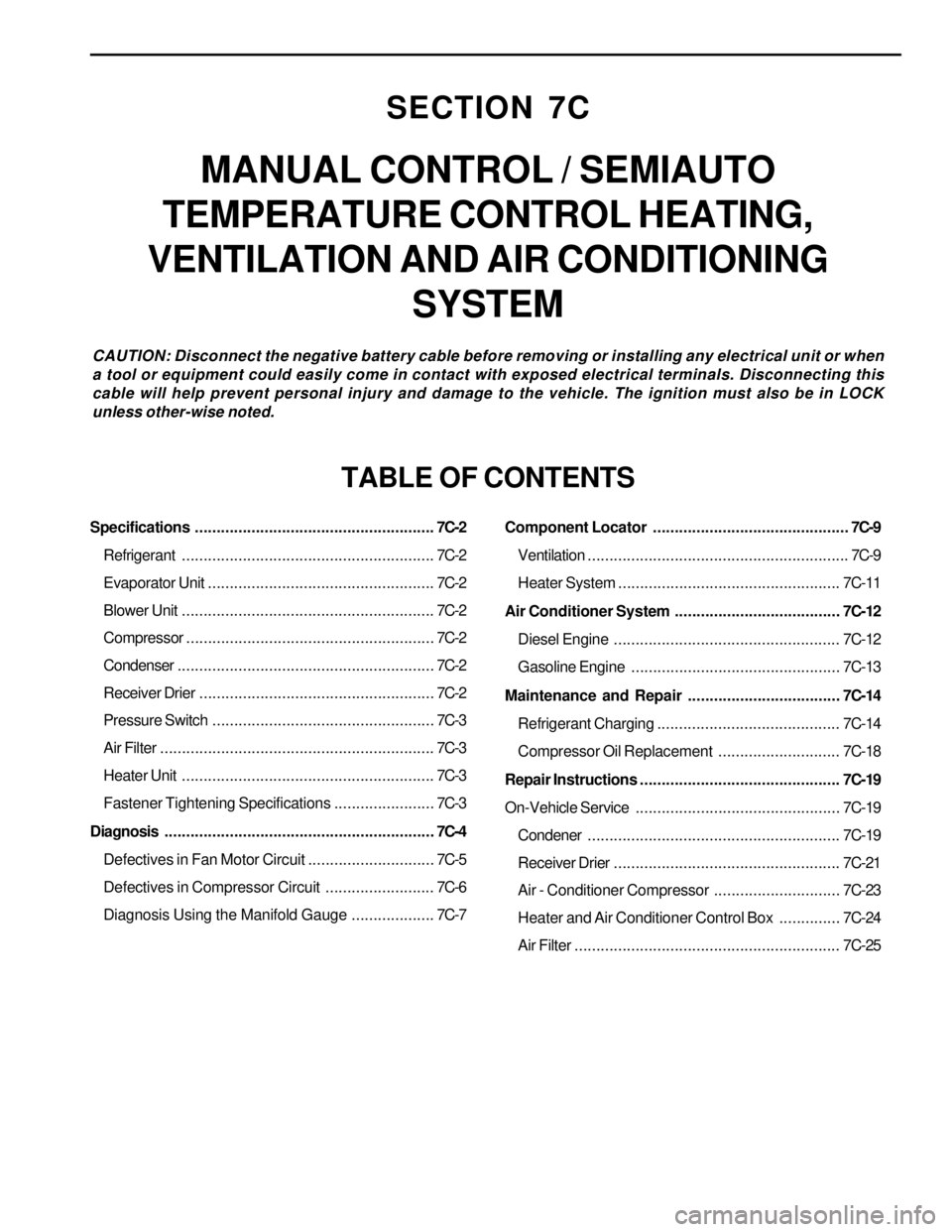
SECTION 7C
MANUAL CONTROL / SEMIAUTO
TEMPERATURE CONTROL HEATING,
VENTILATION AND AIR CONDITIONING
SYSTEM
CAUTION: Disconnect the negative battery cable before removing or installing any electrical unit or when
a tool or equipment could easily come in contact with exposed electrical terminals. Disconnecting this
cable will help prevent personal injury and damage to the vehicle. The ignition must also be in LOCK
unless other-wise noted.
TABLE OF CONTENTS
Specifications.......................................................7C-2
Refrigerant..........................................................7C-2
Evaporator Unit....................................................7C-2
Blower Unit..........................................................7C-2
Compressor.........................................................7C-2
Condenser...........................................................7C-2
Receiver Drier......................................................7C-2
Pressure Switch...................................................7C-3
Air Filter...............................................................7C-3
Heater Unit..........................................................7C-3
Fastener Tightening Specifications.......................7C-3
Diagnosis..............................................................7C-4
Defectives in Fan Motor Circuit.............................7C-5
Defectives in Compressor Circuit.........................7C-6
Diagnosis Using the Manifold Gauge...................7C-7Component Locator.............................................7C-9
Ventilation............................................................7C-9
Heater System ................................................... 7C-11
Air Conditioner System...................................... 7C-12
Diesel Engine .................................................... 7C-12
Gasoline Engine................................................ 7C-13
Maintenance and Repair................................... 7C-14
Refrigerant Charging .......................................... 7C-14
Compressor Oil Replacement............................ 7C-18
Repair Instructions.............................................. 7C-19
On-Vehicle Service............................................... 7C-19
Condener.......................................................... 7C-19
Receiver Drier.................................................... 7C-21
Air - Conditioner Compressor............................. 7C-23
Heater and Air Conditioner Control Box.............. 7C-24
Air Filter............................................................. 7C-25